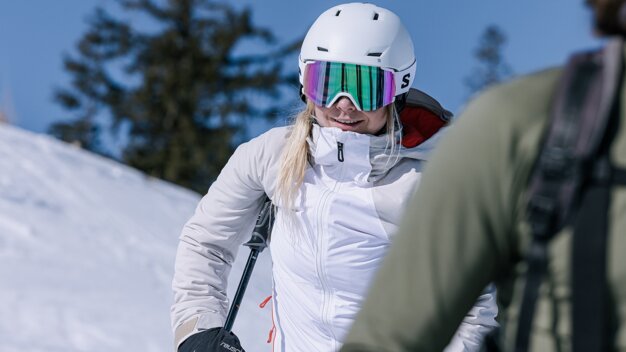
Annoying, even more annoying, fogged-up ski goggles! Many people are familiar with the problem, but very few winter sports enthusiasts know what to do about it. We asked the experts at INTERSPORT Rent for their best tips on how to prevent foggy ski goggles.
In this context we answer some questions right away: Why do ski goggles fog up and what does your helmet have to do with it? It's all so you can get a clear view through your goggles the next time you're on the mountain.
Why do ski goggles fog up?
To answer that question, let's take a little trip into physics. When the warm, moist air between your face and goggles comes into contact with the cold lenses, the water vapor condenses and fine water droplets form on the inside of the goggles. The greater the temperature difference, the greater the effect. The water droplets on the lens reflect the incoming light and cloud your vision - the ski goggles fog up on or between the lenses. This phenomenon can be observed not only with ski goggles, but also with older windows in winter.
Plus, constantly putting on and taking off your goggles increases fogging. Or - more common than you might think - they don't fit properly! Goggles that are too tight promote condensation of body heat on or between the lenses. That's why it's important to buy ski goggles in the right size!
Causes of foggy ski goggles at a glance:
- Temperature difference: Too large a difference between the inside and outside temperature causes moisture to condense on the inside.
- Incorrect fit: Goggles that are too tight or incorrectly positioned prevent air circulation.
- Seals that are too old: The ventilation systems are often covered with foam, as are the frames of the ski goggles. Over the years, this foam becomes brittle and loses its structural integrity, which means that moisture cannot escape optimally.
- Worn anti-fog coating: Over time, the coating on the goggles wears off. Too frequent or improper cleaning can also be the cause.
- Blocked ventilation: An incorrect or poorly fitting ski helmet can block the ventilation openings on the top.
- Rising breath: When warm breath – for example, from ski masks – gets under the ski goggles, moisture settles inside the goggles.
The RENTertainers have put together six tips to counteract these causes.
Tip 1: Pay attention to the product details
When buying your first pair of ski goggles, it is important to focus on the essentials. Low-priced models in particular tend to skimp on details that would prevent the goggles from fogging up. The most important features include:
- Whether there is an anti-fog coating.
- Are there large ventilation slots around the frame?
- Look for models with spherical lenses that allow more space between the lenses and the face.
To learn more about finding the perfect fit for your ski goggles, check out our ski goggles guide!
Tip: Did you know that there are special ski goggles for people who wear glasses? So-called OTG goggles are designed to fit over them.
Tip 2: Store your ski goggles in a warm place
Good ski goggles deserve a warm place! In other words, ski goggles that are stored in the boot or basement will fog up faster. This is due to the difference in temperature. If the goggle is stored at room temperature, the material is already slightly prewarmed.
Tip 3: Do not wipe or rub your ski goggles
When your vision is slightly blurred, it's easy to wipe the outside of your ski goggles without thinking. This is a big mistake! Rubbing will roughen the surface of the lens over time, which can scratch the mirror and colour coatings with snow and dirt. This results in reduced visibility.
Also, do not wipe the inside of the goggles with a cloth too often. Over time, the anti-fog coating will wear off and the surface structure will change, making it even easier for moisture to adhere.
Tip: If possible, air out the inside of the lens briefly in fresh air. If the outer lens is dirty, use the supplied cleaning cloth or another microfiber cloth. Read our other tips on how to clean your goggles properly!
Tip 4: Position your ski mask correctly
On bitterly cold days, many winter sports enthusiasts reach for a warm ski mask or balaclava. They keep your head nice and warm, which is generally a good thing. However, the disadvantage is that if they don't fit properly, the warm, moist air from your nose and mouth is directed straight under your ski goggles. When it's really cold, the fabric of the ski mask should not come into direct contact with the foam padding of the ski goggles to maintain air circulation.
Tip 5: Check the ventilation slots
Sometimes it happens in heavy snow, sometimes unintentionally because of a thick scarf or an ill-fitting ski helmet: the vents are covered or blocked with snow. As a result, air cannot circulate and moisture accumulates on the lenses. Check the vents regularly to make sure they are clear and shake them out if necessary!
Tip: Over time, the foam inside the seals can also become porous, which also reduces the breathability of the goggles.
Tip 6: Do not "rest" your ski goggles on your forehead
It's no secret that we sweat a lot on our heads. So make sure you take off your ski goggles during breaks and don't just pull them down to your forehead, as this will cause the lenses to fog up due to sweat and heat! The same applies to ski hats, as they are usually warm and humid too. It's better to take them off completely and store them in a place where air can circulate.
The role of a helmet in preventing foggy ski goggles
A well-fitting helmet can make all the difference when it comes to foggy ski goggles. This is because it significantly affects the air circulation and temperature around the goggles. Therefore, make sure that the ventilation openings on the top are not completely covered by the helmet. Otherwise, the warm, humid air may not be adequately vented and may condense on the inside of the goggles.
In addition, moisture on the ski helmet, such as snow or sweat, can cause the goggles to fog up. This is especially the case when they are placed on a wet helmet. Temperature differences and poor air circulation increase this risk.
Tip: When buying your ski goggles and helmet, make sure that they are compatible with each other. This will ensure that warm air can be effectively removed from both the goggles and the helmet.
Tips for using helmets and ski goggles:
- Remove snow, ice and moisture from your helmet before putting on your goggles.
- Choose a helmet that is compatible with your ski goggles and whose ventilation systems complement each other and do not block each other.
- Do not place the goggles on a wet or sweaty helmet.
At our INTERSPORT Rent locations, you can get advice from our winter sports experts and try on the right ski goggles with a compatible ski helmet. We look forward to seeing you.
Frequently asked questions about foggy ski goggles
What are the best ski goggles for bad weather?
In bad weather, ski goggles with clear lenses are generally recommended. When packing your rucksack, you should always carry a spare pair of goggles or replacement lenses so that you can react to changing weather conditions.
Can I clean my goggles with shaving foam?
We do not recommend cleaning goggles with shaving cream, as there is a risk that the ingredients will react with the colour and mirror coating on the outside or the anti-fog coating on the inside. This would cause damage and reduce visibility.
Why do my goggles fog up in cold weather?
The reason is the temperature difference between the inside of the goggles and the ambient temperature. Because warm air contains more water, the inside of the goggles starts to fog up as soon as it comes in touch with the cold lenses.
INTERSPORT Rent tip
The RENTertainer recommends
When buying ski goggles, make sure they are compatible with your existing ski helmet in terms of ventilation. Otherwise, you run the risk that the air inside the goggles will not be able to escape, even though the goggles have large vents. If your goggles still fog up, air them outdoors and avoid wiping them too often to preserve the coating.
You can find the right ski goggles and even more helpful advice in our 800+ shops. Our RENTertainers are looking forward to seeing you.
Related articles
You may also be interested in:









